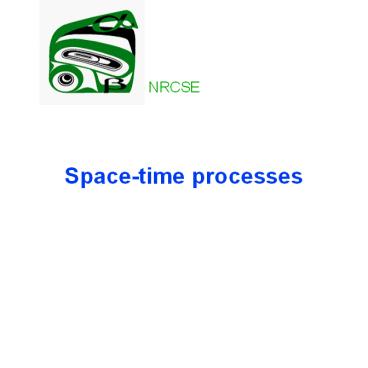Space-time processes - PowerPoint PPT Presentation
1 / 39
Title:
Space-time processes
Description:
Cov(Z(x,t),Z(y,s))=CS(x,y)CT(s,t) Nonseparable alternatives ... grass prairie (38.8N, 99.3W) in Hays, Kansas, between 1932 and1972 (41 years) ... – PowerPoint PPT presentation
Number of Views:21
Avg rating:3.0/5.0
Title: Space-time processes
1
Space-time processes
NRCSE
2
Separability
- Separable covariance structure
- Cov(Z(x,t),Z(y,s))CS(x,y)CT(s,t)
- Nonseparable alternatives
- Temporally varying spatial
covariances - Fourier approach
- Completely monotone functions
3
SARMAP revisited
- Spatial correlation structure depends on hour of
the day
4
Brunos seasonal nonseparability
- Nonseparability generated by seasonally changing
spatial term - (uniformly modulated at each time)
- Z1 large-scale feature
- Z2 separable field of local features
- (Bruno, 2004)
5
General stationary space-time covariances
- Cressie Huang (1999) By Bochners theorem, a
continuous, bounded, symmetric integrable C(hu)
is a space-time covariance function iff - is a covariance function for all w.
- Usage Fourier transform of Cw(u)
- Problem Need to know Fourier pairs
6
Spectral density
- Under stationarity and separability,
- If spatially nonstationary, write
- Define the spatial coherency as
- Under separability this is independent
- of frequency t
7
Estimation
- Let
- (variance stabilizing)
- where R is estimated using
8
Models-3 output
9
ANOVA results
Item df rss P-value
Between points 1 0.129 0.68
Between freqs 5 11.14 0.0008
Residual 5 0.346
10
Coherence plot
a3,b3
a6,b6
11
A class of Matérn-type nonseparable covariances
- ?1 separable
- ?0 time is space (at a different rate)
spatial decay
temporal decay
scale
space-time interaction
12
(No Transcript)
13
Chesapeake Bay wind field forecast (July 31, 2002)
14
Fuentes model
- Prior equal weight on ?0 and ?1.
- Posterior mass (essentially) 0 for ?0 for
regions 1, 2, 3, 5 mass 1 for region 4.
15
Another approach
- Gneiting (2001) A function f is completely
monotone if (-1)nf(n)0 for all n. Bernsteins
theorem shows that for some
non-decreasing F. In particular, is a spatial
covariance function for all dimensions iff f is
completely monotone. - The idea is now to combine a completely monotone
function and a function y with completey
monotone derivative into a space-time covariance
16
Some examples
17
A particular case
a1/2,g1/2
a1/2,g1
a1,g1/2
a1,g1
18
Velocity-driven space-time covariances
- CS covariance of purely spatial field
- V (random) velocity of field
- Space-time covariance
- Frozen field model P(Vv)1 (e.g. prevailing
wind)
19
Irish wind data
- Daily average wind speed at 11 stations, 1961-70,
transformed to velocity measures - Spatial exponential with nugget
- Temporal
- Space-time mixture of Gneiting model and frozen
field
20
Evidence of asymmetry
Time lag 1 Time lag 2 Time lag 3
21
A national US health effects study
22
(No Transcript)
23
Trend model
- where Vik are covariates, such as population
density, proximity to roads, local topography,
etc. - where the fj are smoothed versions of temporal
singular vectors (EOFs) of the TxN data matrix. - We will set m1(si) m0(si) for now.
24
SVD computation
25
EOF 1
26
EOF 2
27
EOF 3
28
(No Transcript)
29
Kriging of m0
30
Kriging of r2
31
Quality of trend fits
32
Observed vs. predicted
33
A model for counts
- Work by Monica Chiogna, Carlo Gaetan, U. Padova
- Blue grama (Bouteloua gracilis)
34
The data
Yearly counts of blue grama plants in a series of
1 m2 quadrats in a mixed grass prairie (38.8N,
99.3W) in Hays, Kansas, between 1932 and1972 (41
years).
35
Some views
36
Modelling
- Aim See if spatial distribution is changing with
time. - Y(s,t)??(s,t) Po(?(s,t))
- log(?(s,t)) constant
- fixed effect of temp precip
- trend
- weighted average of principal fields
37
Principal fields
38
Coefficients
39
Years































